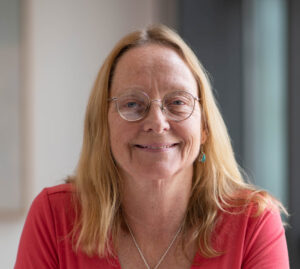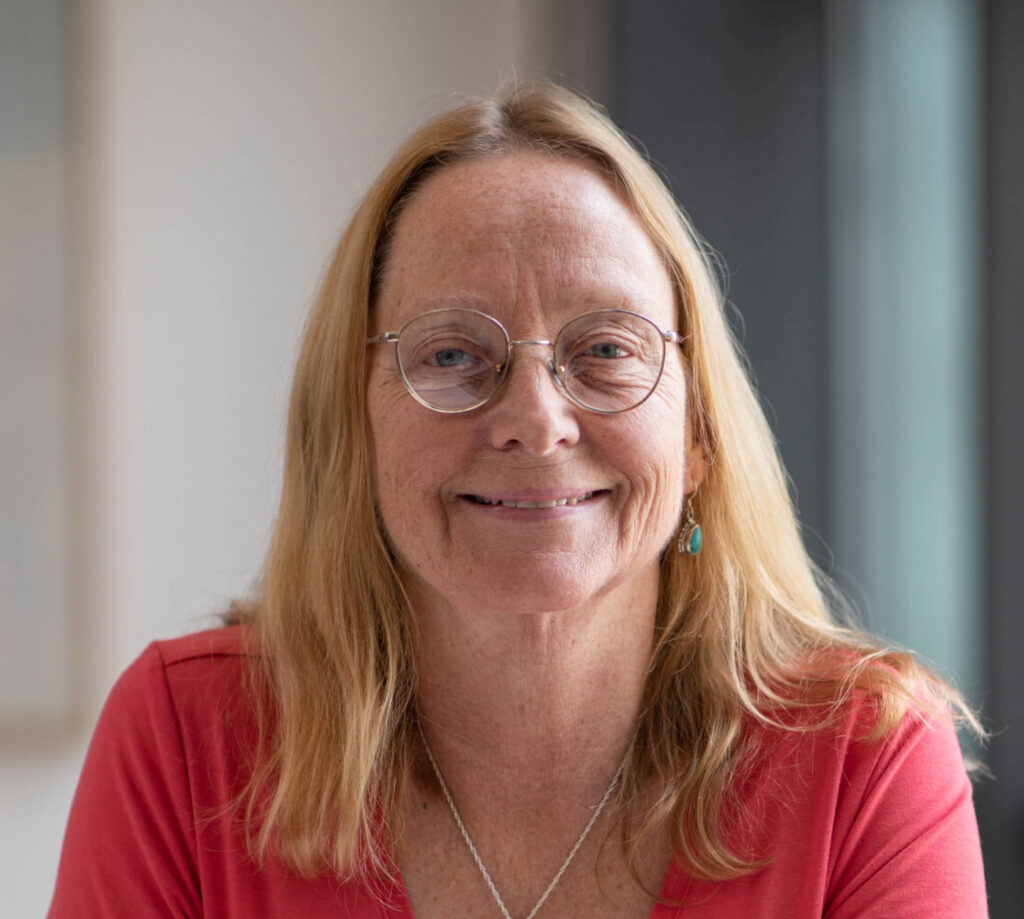
Complex multicellular organisms have mastered the art of specialization; embryonic stem cells give rise to a multitude of different cell types that perform specific functions. Later, adult stem cells dedicated to specific tissues maintain and repair many organs in the body throughout life. Some specialized cell types, like skin, blood, lining of the intestine and colon, and sperm are continually replenished, each from their own dedicated adult stem cells. When such adult stem cells divide, they must not only spawn cells able to specialize into the correct cell type(s) but also produce new stem cells to maintain regenerative capacity.
Margaret “Minx” Fuller studies how male germ cells balance self-renewal versus differentiation to both maintain the stem cell population and continually produce sperm cells. Her research has helped uncover chemical signaling pathways and cellular mechanisms that underlie this process. By studying male germ cells within the context of their cellular neighborhood, Fuller showed that signals coming from surrounding cells coordinate with behavior of cytoskeleton components to induce the stem cells to divide asymmetrically. Studying how stem cells replicate and retain their ability to generate specialized cells could have important implications in cancer research as well as regenerative medicine.
For her achievements, Fuller has been awarded the 2022 Genetics Society of America Medal, which recognizes outstanding contributions in the field of genetics in the last 15 years.
“I don’t see many people who so seamlessly go back and forth between understanding of genetics and cell biology and developmental biology,” says Yukiko Yamashita, a Howard Hughes Medical Institute Investigator at MIT and former postdoc in Fuller’s lab. “Always there is clarity in her thinking, and that is her real contribution—that’s why so many people followed to adopt this model system.”
From physics to “APOG”
As an undergraduate, Fuller started out studying physics, but summer research in a biology laboratory changed her direction. “Maybe naively, I thought in physics you need a big machine between you and your questions—a neutrino detector or a synchrotron or whatever,” she says. A sophomore year biology class with laboratory revealed to her many fascinating unanswered questions, and her experiences at the bench the following summer sealed the bill. “I got hooked by the fact that in laboratory biology, you can ask and answer questions with your mind, some test tubes, and a water bath,” she says.
After graduation, she studied microbiology at MIT, where she worked on the protein-protein interactions that regulate virus capsid assembly. “The thing that was drilled into us was ‘APOG’—the awesome power of genetics,” Fuller recalls. Coming from physics, she was fascinated by how cells change shape and how protein-based machines build structures inside the cell. Researching what to study next for her postdoc, Fuller attended a conference on the cytoskeleton, where she was startled to discover that in the entire conference only two presentations, both posters, used genetics. “So I said, aha! This field needs genetics,” Fuller recalls. “I’m going to go do genetics on the cytoskeleton.”
During her postdoc at Indiana University, she studied proteins that interact with and regulate the microtubule cytoskeleton in spermatocytes, the cells that give rise to sperm cells. Working with mutants that effect spermatogenesis, Fuller realized that here was a perfect system to apply forward genetic strategies to investigate the questions that had caught her interest as an undergraduate and postdoc: How do cells change shape? How does the developmental program add layers of regulation on fundamental cellular processes like cell division, transcription and mRNA processing to specify specialized cell types. When she set up her own lab, Fuller shifted to studying spermatogenesis, the process by which stem cells give rise to specialized sperm cells, in its own right. While a lot of labs were working on oogenesis and embryonic development, only a few at the time were studying spermatogenesis.
“She realized the overarching fundamental principles you could learn from studying a tissue where there are stem cells present that continue to divide throughout the whole adult lifespan,” says Julie Brill of the Hospital for Sick Children and University of Toronto, another of Fuller’s former postdocs. “She wasn’t the only one to develop the testis as a model, but Minx is just such a fabulous speaker that she also really brought people into the system.” As an example, Brill says, Fuller organized a “testis workshop” during the Annual Drosophila Research Conference, which helped create a community among researchers who might otherwise see themselves as competitors. “We all met each other and learned what everybody else was doing,” Brill says. “She’s so good at organizing and inspiring others around her.”
Pre-programmed versus environmental
Fuller’s work shed light on the question of whether the daughter cell fates were determined by pre-programming within the stem cell or by chemical signals coming from the “niche,” the environment outside the cell. “One of the major ideas in the field was that there was a niche, a local microenvironment that instructed the stem cells to maintain stem cell identity,” she says. This idea hadn’t been proven, because the standard procedure at the time was to isolate, sort, and transplant cells before evaluating their stem cell potential. “Well, you can’t study the role of the microenvironment if the first thing you do is take the cells out!” Fuller says. “I realized, I have a great system in my hands in my lab for studying the role of the microenvironment in stem cell biology, right here in the fly testis.”
In addition to signals from the microenvironment, Fuller’s work showed that stem cells also have internal mechanisms that bring about asymmetric cell division. The centriole is a microtubule-based structure that organizes the mitotic spindle, and when the cell divides, the two centrioles migrate to opposite poles. By marking the oldest centriole, Yamashita while in Fuller’s lab discovered that the older centriole stays anchored in the stem cell, while the cell that inherits the younger centriole goes on to become differentiated. “This whole mechanism of orienting the spindle and asymmetric division—I think that has been most impactful outside my immediate field,” Fuller says. Now, people studying other types of adult stem cells also look for whether or not the cells undergo asymmetric division, she says, partly inspired by the observations from the testis. Moving down the differentiation lineage, Fuller’s laboratory is now focusing on uncovering the mechanisms that regulate the switch from precursor cell proliferation to turning on expression of the correct cell type specific gene expression program.
Most recently, Fuller contributed to the Fly Cell Atlas project, an ambitious effort to catalog the gene expression profiles of all the cells in Drosophila. “It was during COVID, so we had a big Zoom jamboree of maybe 12 labs that contributed to that paper,” Fuller says. “It’s been a vehicle for open communication among labs that could have been competing, but we’re collaborating and it’s just so much fun.”
Over the years, Fuller says she has gotten great joy from seeing all the projects her trainees have been able to take with them when they leave to start their own labs. “The most gratifying thing to me is that a group of my former postdocs and students got together and wrote a nomination letter,” Fuller says. “I think my most important contribution to science has been all these fantastic people who are now doing their own science.”
The Genetics Society of America Medal honors an individual member of the Society for outstanding contributions to the field of genetics in the last 15 years. GSA established the Medal in 1981 to recognize members who exemplify the ingenuity of the GSA membership through elegant and highly meaningful contributions to modern genetics.































